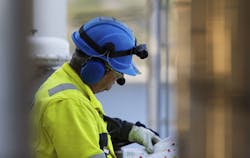Augmenting the Future with AR, Wearables, and Mobile Devices
In an era where robots and automation are increasingly relevant, there are many factors to weigh when integrating new technology into your workplace. As hardware and software platforms continue to improve, the market for new technologies like mobile devices, augmented reality, and wearables has significant potential for growth. While many of these technologies are not ready for broad integration, now is the time to begin evaluating how best to apply them for very common and very expensive business problems.
For instance, these technologies are often best suited to automate repetitive, low-level tasks and to manage the collection, transfer, and analysis of data. The objective is not to automate jobs, but rather to automate certain tasks to free up our time and energy so we can focus on our strengths as humans (creativity, curiosity, and empathy).
Currently, offices across the globe are already integrating mobile devices, augmented reality and wearables into their workspaces, but are doing so ineffectively. In many cases, existing enterprise software and equipment automation solutions do not adequately engage the workforce, leaving employees overwhelmed by data overload. Sifting through data that may or may not be relevant can result in workers wasting more than two-thirds of their time on unproductive activities.
Sifting through data that may or may not be relevant can result in workers wasting over two-thirds of their time on unproductive activities.
We need to get smart about how we automate our workplaces and how we integrate new technology into our work and personal lives. This will require us to understand and differentiate between the three broad categories of smart technologies to decide which (if not a mix of all three) is best suited for our work environment:
- Augmented reality
- Wearables
- Mobile devices
Striking the right balance allows us to capture the most value and effectiveness while addressing day-to-day business problems.
In the workplace, AR can leverage contextual awareness and big data to provide workers with additional information to help them do their jobs more effectively.
Automating with AR
Augmented reality (AR) has become one of the most buzzed-about technologies in this current wave of automation and data exchange in manufacturing and related industries, also known as Industry 4.0. I believe this is because of the differentiating value of AR: its ability to present information to the user in context.
AR is an interactive experience of a real-world environment where objects residing in the real world are enhanced by computer-generated visual information. This augmentation of the natural world through AR can come in the form of interactive sounds, graphics, and feedback. In the workplace, AR can leverage contextual awareness and big data to provide workers with additional information to help them do their jobs more effectively. Using AR, you can take someone of a certain skill level and augment their level of expertise and quality of their work to levels which were previously only accessible through time and experience.
For example, AR is suitable for promoting “heads-up” work, where workers receive instructions overlaid onto a real scene, allowing them to follow the instructions without looking away from what they’re working on. Similarly, AR via head-worn wearable devices enables workers to have both their hands available to perform the work and receive dynamic, in-the-moment guidance on what they’re doing. Since AR inherently ‘sees’ the worker’s environment, it has the potential to capture and distribute “tribal knowledge”—information known by certain members of an organization which is shared with the broader organization.
In addition, when artificial intelligence is applied to this dataset, insights that were not previously available can be accessed and redistributed to workers through AR, wearable, or mobile devices.
As AR and smart technology are increasingly integrated into workplaces, more jobs will be augmented by these devices. This will automate certain tasks within jobs, empowering many workers to move up the skill-chain—making them more productive for the company and more marketable for themselves. So, while AR and automation seem to compete on the surface in the near-term, the future is one in which automated machines and augmented human workers coexist seamlessly.
The future is one in which automated machines and augmented human workers coexist seamlessly.
Wearables for Workers
It is worth noting that AR is also a wearable. However, as the market has evolved, AR and other wearables have gone down different paths. When you hear the word “wearable” you likely picture a fitness tracker or another popular consumer product like a smart watch, whereas AR often refers to “AR glasses”. The key differentiating value of wearables is their ability to collect real-time data that is based on the individual, their ease of use, and their capability to provide information that is quickly consumable. With the increasing popularity of what we know as wearables, why not use similar devices in our work environments?
For example, wearable devices enable workers to receive location- and task-based instructions that are contextually relevant, such as safety alerts. They can also provide an easy means of disseminating tribal knowledge and guidance via a simple interface where the worker can receive actionable intelligence in the form of notifications. Wearables can also leverage data collected in the field and combine that with edge computing to produce nearly instant insights and guidance for workers.
This immediate feedback loop is particularly critical in situations where data expires quickly and internet access may be limited. Once the job is completed and internet access is restored, this data can be transmitted to the cloud for storage and further analysis.
In summary, when evaluating these technologies, I would suggest that you see AR as a tool to improve productivity and wearables as a tool for communication and data collection. Now that we’ve covered some applications for AR, wearables, and mobile devices to help automate the future, which do you see yourself applying at your company? Comment below.
Gabe Batstone is the co-founder and CEO of contextere.
References
Schueffel, Patrick (2017). The Concise Fintech Compendium. Fribourg: School of Management Fribourg/Switzerland.
About the Author
Gabe Batstone
Co-founder and CEO
Gabe Batstone has two decades of experience implementing emerging technology across multiple industries on six continents. This has included innovations for digital oilfield, intelligent vehicles, smart city, future soldier, and augmented reality for the enterprise. Gabe has worked for market leaders in the aerospace, defense, automotive, and energy markets, including NAVTEQ, CAE, and NGRAIN.




